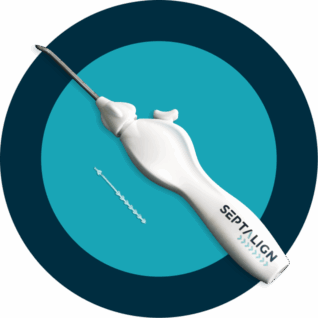
SOUTH SAN FRANCISCO, Calif.–(BUSINESS WIRE)–Spirair™, an early-stage company pioneering minimally invasive solutions that help ENTs advance care for their patients, today announced it has received 510(k) clearance from the U.S. Food and Drug Administration (FDA) for its SeptAlign™ System. This comes on the heels of FDA clearance of the SeptAlign bioabsorbable Implant in August 2023 and represents the final step in completing the FDA clearance process for the SeptAlign System.
Nasal septal deviation (NSD) is one of the most common causes of nasal airway obstruction (NAO), a condition that makes it difficult to breathe through the nose.1 Treatment options for symptomatic NSD have been limited to either over-the-counter medications to alleviate symptoms or invasive surgical techniques such as traditional septoplasty to address the structural issues that cause these symptoms. Traditional septoplasty can require significant time away from work, with approximately 40% of patients requiring two or more weeks off for recovery.2
“Demand for minimally invasive treatment options has been steadily rising across healthcare in recent years, but there have been few such options for people suffering from symptomatic NSD,” said Benjamin Bishop, CEO of Spirair. “SeptAlign is a minimally invasive treatment that can be safely and conveniently performed under local anesthesia and enables ENTs to expand their treatment options for more patients.”
SeptAlign has been clinically demonstrated to straighten minor cartilaginous septal deviation.3 SeptAlign can be performed in any site of service as part of standard septoplasty techniques, including the office, the operating room (OR), and/or the ambulatory surgery center (ASC). The bioabsorbable SeptAlign implant is inserted in the cartilage near the front of the nose and holds the straightened septum under tension, dissolving within six months. Studies have shown that NSD correction can improve nasal breathing, and cartilage can maintain a new shape after being held under tension by absorbable implants.4 With SeptAlign, because no cartilage is removed, ENTs can expand their therapeutic offerings for more patients without limiting future treatment options.
“Septal deviation is one of the primary contributors to nasal airway obstruction. Physicians can’t move septal cartilage with medicines so mechanical correction through surgery has been the best choice for many patients. Until SeptAlign, there has been little to no change in how we perform septoplasty,” said David Yen, M.D., FACS, chief of otorhinolaryngology at St. Luke’s University Health Network in Bethlehem, Pa. “SeptAlign is uniquely suited to treat cartilaginous septal deviations at the nasal valve, the narrowest cross-sectional area, with less recovery for the patient.”
SeptAlign is currently being investigated as part of two IRB-approved nonsignificant risk (NSR) U.S. clinical trials. Following the clearance of the SeptAlign system, Spirair plans to begin a Series B fundraising round and start commercialization.
About Spirair
Spirair is an early-stage company pioneering minimally invasive solutions that help ENTs advance care for their patients by providing strong outcomes and a better patient experience. Spirair is committed to developing new therapies that can easily integrate in any ENT’s treatment algorithms so they can help more of their patients breathe better. Its first product, SeptAlign™, is used to support and straighten minor deviations in septal cartilage when sufficient healthy cartilage exists, and the cartilage is appropriately mobilized utilizing standard septoplasty techniques. The company got its start through the Stanford Biodesign Innovation Fellowship, a program that equips aspiring innovators with a proven, repeatable process to identify important health-related needs, invent novel health technologies to address them, and prepare to implement those products into patient care. Visit spirair.com for more information.
Contacts
Shay Smith
shay@launchready.agency
(707) 971-9779
1. Clark DW, Del Signore AG, Raithatha R, Senior BA. Nasal airway obstruction: Prevalence and anatomic contributors. Ear Nose Throat J. 2018 Jun;97(6):173-176. doi: 10.1177/014556131809700615. PMID: 30036414.
2. Chidambaram A, et al. Anticipated absence from work (‘sick leave’) following routine ENT surgery: are we giving the correct advice? A postal questionnaire survey. Clin Otolaryngol Allied Sci. 2001 Apr;26(2):104-8. doi: 10.1046/j.1365-2273.2001.00433.x. PMID: 11309049.
3. Data on file at Spirair.
4. Imphongsai S, Eshraghi Y, Totonchi A, Midler J, Abdul-Karim FW, Guyuron B. Effect of different suture materials on cartilage reshaping. Aesthet Surg J. 2009;29(2):93-97. doi:10.1016/j.asj.2009.01.016. (Histological evaluation of cartilage reshaping in rabbits using PDO suture)
Enter your contact information below to receive more information or request a demo.
SEPTALIGN™ Indications for Use: SeptAlign™ is used to support and straighten minor deviations in septal cartilage when sufficient healthy cartilage exists, and the cartilage is appropriately mobilized utilizing standard septoplasty techniques.
TURBALIGN™ Indications for Use: TurbAlign™ is intended to separate the middle turbinate from the lateral nasal wall during the clinically relevant healing phase associated with sinus surgery (e.g., endoscopic sinus surgery, FESS). The implant provides short-term fixation of the middle turbinate to the nasal septum and thus minimizes the risk of adherence to the lateral wall.
Caution: Federal (USA) law restricts this device to sale by or on the order of a physician.
SPIRAIR®, SEPTALIGN™ and TURBALIGN™ are trademarks of Spirair Inc.
MRK-010-C Copyright © 2025 Spirair, Inc.
